Most of your students can probably speak in complete sentences, right? So when it comes to writing, why does all of that seem to go out the window?!
Our students are usually full of ideas and great stories, but that can get lost in translation when it’s time to put pencil to paper. You might have seen pieces of writing similar to this:
- The student who has a stream of consciousness going, but never knows when to stop!“We went to the park and it was so much fun and it was sunny and I went down the slide and my mom was there and we had the best time!”
- The student who knows there should be periods, but has no idea where to put them. “For my birthday party. There were balloons and cake I got. A lot of presents.“
- The student who loves using periods way.too.much. “I saw. A movie. It. Was scary. My. Friend. Luke. Was with. Me.”
In this post, I’ll guide you through some tricks to help your students write in complete sentences. As with most things, teacher modeling is going to be key!
If, after you watch the video, you’re looking to go more in-depth on the topic of writing instruction, I’ve got a FREE webinar for you! Check that out here: How to Implement Writing Workshop in K-2
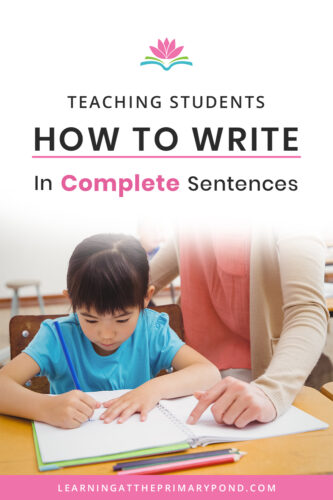
Watch the video to learn my tricks for getting students to write in complete sentences!
Transcript if you prefer to read:
Hey, I’m Alison from Learning at the Primary Pond. I’m a literacy specialist and in this video, I’m going to share with you three tricks to help your students write in complete sentences. Most of these tips are most relevant for first grade and up. Some, you could probably adapt to kindergarten as well.
Let’s talk writing complete sentences. This can be very hard for young students, and even I would say, for older students in the elementary grades. I think what’s interesting is that sometimes kids can write a complete sentence in isolation, like if we maybe are telling them very specifically, “Okay, answer this question in a complete sentence.” They can probably do it verbally, maybe even in writing. But then when they’re writing a more extended piece with multiple sentences, things all kind of fall apart.
That is very common. It’s very normal. And some of it honestly is just time and repetition and support from us. If your kids are not writing in complete sentences or they’re writing in just run-on sentences, know that it’s normal. Also know that there are definitely things you can do to support them.
One of those things is to start talking about subject and predicate. Subject and predicate aren’t just abstract grammar concepts. I don’t know about you, but when I was young, we would diagram sentences and talk about subject and predicate in that sense. The subject and predicate are actually really useful in teaching for how to write in complete sentences.
The subject of course is who or what the sentence is about, and then the predicate is what is happening in the sentence. That’s how I would explain it to my primary grades kiddos. In my small group writing bundles, I have little strips with parts of a sentence. Students practice putting the sentence together. They can also sort subjects and predicates. So, they’re making the complete sentences, but then they’re also sorting is this part the subject, or is this part the predicate?
We want to talk about this concept when we’re doing our grammar lessons, but we also want to make sure that we’re relating it to writing. If you notice that a child has only written the subject of a sentence and maybe there’s a period afterwards, say, “Hey, I noticed that you put this subject, now we need to do the predicate.” So really tie these concepts into when you’re coaching them one on one with writing. When you’re modeling for students, be sure to sometimes model just writing part of a sentence. Then say “What’s missing?” Have them guide you through “Oh, here’s the predicate, but I have no subject.” Again, connect this into what you’re doing as well as doing activities like this, subject and predicate little sort here.
Now, let’s move on to the second strategy. The second strategy to help students write in complete sentences is to work at the sentence level. And when I say work at the sentence level, what I mean is to sometimes just pull out one sentence at a time and just have them focus on that.
If you’ve noticed, for example, that maybe your kids can write a sentence when you tell them, “Hey, just write this sentence.” But then when they’re writing a story or more extended piece of something, have you ever seen where they’ll just write and it’s like stream of consciousness? It’s like this never ending thought or maybe they’ll put what should be three separate sentences into one. It’s very common for little ones to do that, even, like I said, older students sometimes as well.
This is where I think working at the sentence level can be really helpful. What you can do is have the kids take a sentence that they want to include in their writing and actually put it on a strip of paper or just a different sheet of paper than their actual story. Then you’re going to just focus on that sentence. You could even have the whole class write one sentence and you’re doing it as a dictation. The point is they might be putting that sentence back into their writing later. First though they’re going to pull it and just focus on that sentence.
When they’re writing the sentence this way, you might have them, especially if they’re kindergarten or first grade, do the line drawing strategy. In the line drawing strategy, you would have them rehearse the sentence a couple of times, meaning they’re planning what they’re going to write. Then they say the sentence two times. After that they draw a line for each word. If the sentence was, “We played at the park,” they would write a total of 5 lines for each word. As they’re writing, the lines remind them of the words in this sentence because for a little one, sometimes it’s hard for them to even just remember what they plan to write.
This strategy helps them with spacing. It helps them every time they write a word, they repeat, they go back. “We played at…” They read it again. “We played at the…” “We played at the park.” They’re constantly rereading and going back. This line drawing strategy can help a little bit, but as you’re are having the kids pull this sentence out of their writing, you can also come back to talking about subject and predicate. Where is your subject? Where is your predicate? Where is your capital letter? Where is your period? You can just go more in depth on that sentence and help them focus on it as opposed to if they’re supposed to be writing this whole paragraph or this whole story.
Now, when their sentence is the way it’s supposed to be, then they can go and put it back into their writing. We’re always making that connection. We’re not just doing one sentence. We’re doing this for the purpose of writing a paragraph or writing a story. Helping them just focus on one sentence at a time can be really, really helpful. You could also do peer editing where they’re helping each other with their sentences. Lots of options, but working at the sentence level can be extremely helpful. This strategy could be something you do with your whole class, but maybe it’s also just something you do with a small group. They bring one sentence, you work on it at the table, and then they go back to their seats and continue writing.
My last little tip is just to have some kind of anchor chart. Maybe you’ve taught subject and predicate. You’ve worked at this sentence level. They’re going to forget sometimes. That’s very normal. Have some kind of anchor chart that includes what the parts of a sentence are – subject, predicate, capital letter, period. Write whatever you want them to include, and have that somewhere posted plainly in the classroom. Another option is to have them put something in their writing folder that they can refer back to. Maybe when you’re doing peer editing or they’re editing their own work, they have a little checklist that again includes the parts of a sentence and what a complete sentence should have. Everything that you do, you want to also visually represent for them in something that they can continue to refer back to.
Last, but not least, don’t forget this does take time. Sometimes it can be frustrating when we’re thinking “I taught this, we worked on this already.” I hear you. We start to think “How much more time is this going to take?” But especially when we’re working with the little ones, it does just take that time and repetition. It doesn’t mean you’re necessarily doing anything wrong. If they’re just not getting something, it might just mean you need to explain it a different way or just give them more time.
All right. I hope that this was helpful. If you would like to learn more about teaching writing in kindergarten, first grade, and second grade, that’s actually a huge passion of mine. I have a one-hour, in depth workshop where you can really dive in with me. I talk about how to get kids to become more independent writers, how to get them to write more, and how to set up your writing time so that the kids work independently. flows. I would love to invite you to watch that workshop. I will include a link to this along with this video so you can get signed up for that writing webinar. Again, thanks so much for watching. Hope this was helpful.
Conclusion
Students struggling to write in complete sentences is totally normal! As I stated, it takes time and repetition to make these skills a habit. I hope these tips helped!
If you’re looking for lesson plans that target writing skills such as this and others, check out my Small Group Writing Bundles on TpT. I have them for Kindergarten, 1st Grade, and 2nd Grade.
These aren’t complete writing programs – rather, they have an “If…Then” table of contents with problem areas like “students not writing with enough detail,” “students not using punctuation correctly,” “students not using neat handwriting,” etc. – and then there are lesson plans and materials to support you in addressing these issues.
Click any image below to learn more!
Happy teaching!
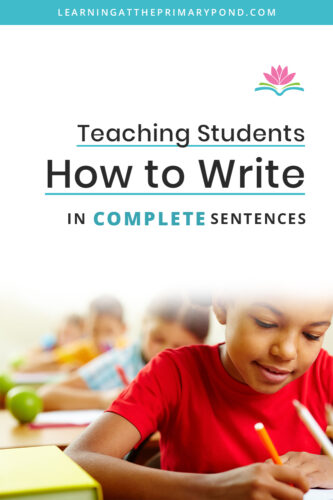




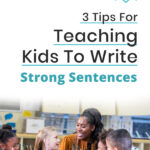
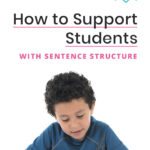
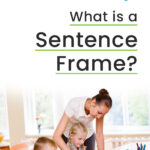
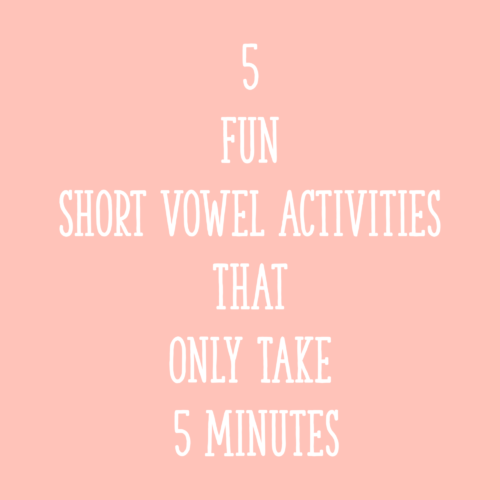
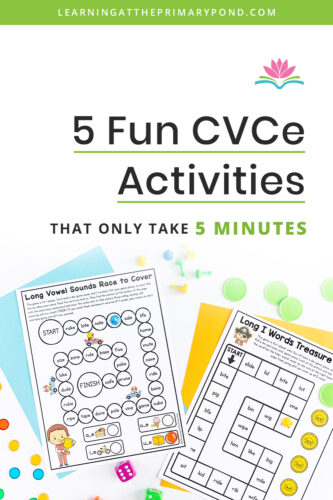







This is a wonderful article! This helps me realize that I am doing some things to help my students become better writers, but I have never tried an anchor chart and I’m excited to give it a try.
Best of luck!!